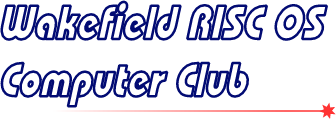Meeting: Vpod and Various Software
Steve Potts and Colin Sutton were the two halves of this double bill. Steve opened, with a quick demo of some of the software that he’s written over the years. This was followed by half an hour of “tips and tricks” on RISC OS that Steve thought people might not know about, with members of the audience adding to those that he had prepared himself. After a quick demo of the Vpod graphics card in his RiscPC, Steve handed proceedings over to Colin. The second part of the evening started with a look at fonts, and was followed by a demonstration of panoramic photo stitching and perspective correction – illustrated by some photos that Colin had taken the previous weekend.
Report by Steve Fryatt
August’s meeting was another evening of short presentations, hastily arranged the weekend before. Rick Sterry opened the night by reminding those present that Chris Hughes would be stepping down as meeting coordinator after September’s meeting, due to a lack of time caused by his other commitments. Chris has done sterling service in this role for many years now, and recent hiccoughs like this month – where other things have caused him to take his eye off our ball – only illustrate how vital the job is.
I can only echo Rick’s request that members think seriously about whether they could take on this important task. It isn’t actually that arduous: since the committee usually decide what topics to cover at meetings (based on suggestions from all our members), the coordinator’s contribution is to liaise with those who have agreed to do talks, making sure that the diary is kept filled and that gaps are highlighted with enough warning for something to be done. Without one person keeping an overall eye on things, there is always the danger of individual meetings being overlooked – as happened this time.
Useful utilities
In the end, the first part of the evening was to be taken by Steve Potts, who started by talking us through some of the utilities that he has written for RISC OS. The first was KbdSt, which turned out to be as compact and economical as its name. Aimed at those with wireless keyboards, which often don’t have any status LEDs, it indicates the state of Caps, Num and Scroll Lock on the iconbar.
The next utility was ConfInfo, which Steve wrote to assist those asking for help on the newsgroups when faced with the question: “how is your machine set up?” Designed to be run either from the desktop or from the command line of a machine that has failed to boot properly, it gathers useful info and saves it into a text file which can then be emailed to anyone who needs to know the contents of CMOS RAM, system variables and the like.
Finally, Steve showed us BgrndCtrl, which provides a flexible way to change the backdrop displayed on the pinboard, either when the machine is started or at regular intervals while it is switched on. A lot of effort seems to have gone into making the system flexible and easy to use, and there were plenty of options for specifying which images to use and how often to change them. Steve said that there were several useful keyboard shortcuts defined, and that once configured the whole application could be hidden from view so that it would get on with its job in the background without getting in the way.
I never knew that
For the next part of his presentation, Steve looked at some of the ‘lesser known’ features of RISC OS. Despite having a script – or at least a set of short notes – he opened this up to the audience and invited us to contribute our own suggestions for tips and tricks that others might not know.
For about half and hour, Steve took us through a tour of his RiscPC, showing us some of the keypresses that can be used when the machine starts (his system is running RISC OS Six, but many of the actions were also present on earlier releases from the Select scheme). He also looked at some of the things that the Adjust button can do, the different uses for F12 and ‘modifier’ keys like Ctrl, Shift and Alt.
As Steve began to run out of things to demonstrate, a number of audience members started to suggest their own tricks that they had found. Altogether, the lot added up to a useful collection of time-saving shortcuts that were fairly evenly spread between those that worked on all versions of RISC OS and those that were only for RISCOS Ltd’s more recent systems.
Finally, Steve mentioned that his machine had one of Advantage 6’s Vpod graphics cards fitted. He showed how the card integrated with RISC OS Six, and gave a demonstration of the range of resolutions and colour depths that it supported – as well as comparing these to what was on offer natively with 1MB of VRAM fitted. An impromptu experiment ensued, using a widescreen monitor that Steve had brought with him, and further investigations took place for those who were interested after the meeting was officially over.
Font management
Colin Sutton followed Steve, and introduced us to his laptop running Virtual Acorn on top of Windows. Over the past few years he has slowly been migrating his RISC OS activities over from a RiscPC, and overall the process seemed to be straightforward. The key issue that he was encountering was the lack of a floppy disc drive on the new machine: he had looked at a USB-attached device, but Virtual Acorn can’t use one of these to read ADFS discs and this makes a lot of old software hard to install.
The main thing that Colin talked about on the RISC OS system was fonts. Over the years he had amassed a large collection of typefaces, both as native designs and as conversions from other platforms. The latter had been achieved using Acorn’s Type 1 conversion utility (as supplied with RISC OS) and the equivalent for TrueType fonts which was sold by EFF.
After dallying with a number of different font managers (including the free Atlanta from David McCormack), Colin had finally settled on a very simple solution in the form of a ‘pseudo-application’ called Novelty. Using this, he could store most of his fonts on a CD and copy those he wanted to use for a given job into Novelty’s application folder. Double-clicking on the application then added the extra fonts to the system, and double-clicking again removed them. Colin told us that he had found this to be the most effective way to manage the fonts available on his system.
Panoramas, and more
Colin then moved on to the evergreen subject of digital photography. As an experienced photographer, he always has new things to talk about at meetings, and this time he started by showing us a set of pictures that he had taken the previous weekend in Millennium Square, Leeds. They showed a large crowd gathering in front of a stage set up at the side of the square, and Colin proceeded to use a piece of Windows-based software (supplied with one of his cameras) to stitch them together into a single panoramic shot. He discussed how he might then decide to crop the picture: ‘Photoshopping’ in missing bits of sky, and cutting out odd heads and arms that came from spectators just out of the bottom of the shot.
Leaving the panoramas behind, Colin showed us another photo that he had taken in Leeds, of the inside of St. Anne’s Cathedral. Due to the restricted space available inside, he pointed out how a number of the verticals – such as the pillars in the arch leading to the chancel – were not in fact vertical. Being a digital image, of course, this kind of problem can be sorted out using software: in this case, using another piece of Windows-based software called ShiftN.
Given the cathedral photograph, the software analysed it looking for sections that it thought should be straight up and down. These were presented to Colin for approval before the image was taken and squashed so that the intended verticals did indeed become vertical. The process was mostly automatic, although Colin showed it could be overridden manually if it looked as though things could be improved.
Having shown how the image of the cathedral could be digitally enhanced, Colin went on to demonstrate the same process with some shots of a cinema that he had taken for a book. In this case he had been unable to stand as far back as he would have liked due to the presence of roads, and so the perspective was not ideal. Again, ShiftN was able to improve things – although Colin stressed that it could not do the impossible, and so was not a substitute for getting the best original image possible.
Some colourful characters
To close, Colin returned to the event that he had stumbled across in Millennium Square that weekend, and showed us some more of the photos that he had taken. The participants had been more than willing to pose for photographs and this, coupled with the brightly coloured and sometimes risqué costumes that they were wearing, had enabled Colin and the other photographers present to get some distinctive and eye-catching shots.
As he worked through the pictures, Colin was able to fill us in on the background stories of the conversations that he had held with the subjects. He said that he hadn’t finally decided what to do with the images as yet, but that he suspected they would probably end up in a display sequence at some point in the future.
Getting the software
Copies of Steve Potts’ software can be found at www.blastzone.demon.co.uk.
ShiftN, as shown by Colin Sutton, is available to download from www.shiftn.de.
The Novelty font management utility can be found in Drobe’s mirror of the Stuttgart FTP site at www.drobe.co.uk/archives/index.php?directory= /ftp.uni-stuttgart.de/pub/systems/acorn/riscos/util/font/.







